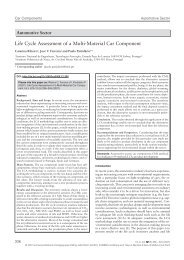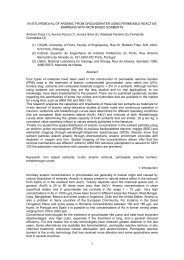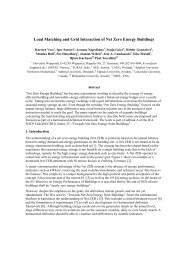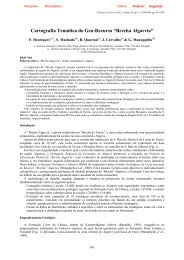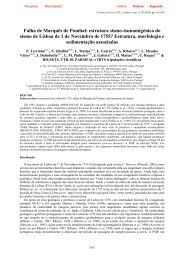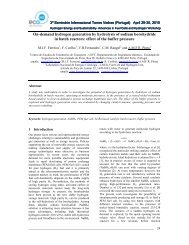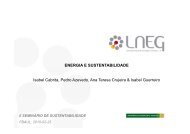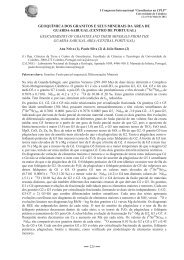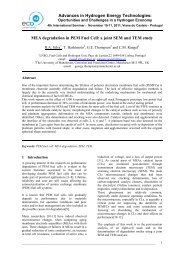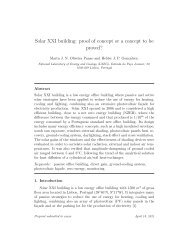Hydrogen production by hydrolysis of sodium borohydride for PEM ...
Hydrogen production by hydrolysis of sodium borohydride for PEM ...
Hydrogen production by hydrolysis of sodium borohydride for PEM ...
You also want an ePaper? Increase the reach of your titles
YUMPU automatically turns print PDFs into web optimized ePapers that Google loves.
International Workshop<br />
Advances on Fuel Cells and the <strong>Hydrogen</strong> Economy<br />
<strong>Hydrogen</strong> <strong>production</strong> <strong>by</strong> <strong>hydrolysis</strong> <strong>of</strong> <strong>sodium</strong> <strong>borohydride</strong><br />
<strong>for</strong> <strong>PEM</strong> fuel cells feeding<br />
R.A.Silva 1 , T.I.Paiva 1, M. Branquinho 1 , S. Carvalho 2 , A.M.F.R. Pinto 2 , C. M.Rangel 1<br />
1, Instituto Nacional de Engenharia, Tecnologia e Inovação<br />
DMTP/UEQM - Electroquímica de Materiais<br />
Paço do Lumiar, 22 1649-039 Lisboa – Portugal<br />
2 Faculdade de Engenharia da Universidade do Porto, R. Roberto Frias, 4000 Porto, Portugal<br />
raquel.silva@ineti.pt; teresa.paiva@ineti.pt, apinto@fe.up.pt; carmen.rangel@ineti.pt<br />
Abstract<br />
In this work, hydrogen is produced <strong>by</strong> a <strong>hydrolysis</strong> process that uses <strong>sodium</strong> <strong>borohydride</strong> as a hydrogen carrier<br />
and storage media. High purity hydrogen is obtained at low temperatures with high volumetric and gravimetric<br />
storage efficiencies; reaction products are non-toxic. The produced hydrogen can be supply on-demand at<br />
specified flow <strong>by</strong> tailor made developed catalyst. <strong>Hydrogen</strong> feeding to a low power fuel cell was accomplished.<br />
According to experimental conditions conversion rates <strong>of</strong> 100% are possible. Catalyst is demonstrated to be reusable.<br />
Keywords: Chemical hydrides, <strong>sodium</strong> <strong>borohydride</strong>, <strong>production</strong> <strong>of</strong> hydrogen, fuel cells<br />
1 Introduction<br />
A major challenge facing our planet today relates to<br />
the problem <strong>of</strong> climate change and its links to<br />
global society's present and future energy needs.<br />
<strong>Hydrogen</strong> and fuel cells are now widely regarded as<br />
key energy solutions <strong>for</strong> the 21st century. These<br />
technologies will contribute significantly to a<br />
reduction in environmental impact, enhanced<br />
energy security (and diversity) and the creation <strong>of</strong><br />
new energy industries.<br />
However, the transition from an energy system with<br />
fossil fuel to a hydrogen-based economy involves<br />
significant scientific, technological and<br />
socioeconomic barriers to the implementation <strong>of</strong><br />
hydrogen and fuel cells as the clean energy<br />
technologies <strong>of</strong> the future. <strong>Hydrogen</strong> <strong>production</strong><br />
and storage continue to be major technological<br />
barriers.<br />
Energy densities, cost, safety and ease <strong>of</strong><br />
manufacture, are amongst the factors to be taken<br />
into account <strong>for</strong> the evaluation <strong>of</strong> storage systems.<br />
Chemical hydrides, particularly <strong>borohydride</strong>s, are<br />
currently being developed as storage options, since<br />
they exhibit good energy densities. Cost effective<br />
recycling methods are needed <strong>for</strong> improvement <strong>of</strong><br />
this option <strong>for</strong> use in selected fuel cell applications.<br />
Sodium <strong>borohydride</strong> (NaBH 4 ) was chosen due to its<br />
high hydrogen content (10.6 wt.%), good storability<br />
in alkaline solution, easy control <strong>of</strong> hydrogen<br />
generation rates, moderate operation temperature<br />
and environmentally benign <strong>hydrolysis</strong> product [1-<br />
3].<br />
NaBH 4 reacts exothermally with water, but the<br />
reaction rate diminishes with time as the <strong>production</strong><br />
<strong>of</strong> NaBO 2 makes the solution alkaline.<br />
Catalysts are essential <strong>for</strong> a controlled constant<br />
hydrogen <strong>production</strong> rate.<br />
NaBH 4 + (2+x) H 2O → NaBO 2.x H 2O + 4H 2↑ (-218 kJmol -1 ) (1)<br />
In this work, <strong>sodium</strong> <strong>borohydride</strong> is the option<br />
taken <strong>for</strong> <strong>production</strong> on-demand hydrogen <strong>for</strong> an<br />
application involving the feeding <strong>of</strong> a low power<br />
fuel cell, which may require hydrogen at a rate <strong>of</strong> 1<br />
Lmin -1 .<br />
2 Experimental and Results<br />
The selected catalyst, apart from appropriate<br />
catalytic activity and suitable kinetics, face issues<br />
<strong>of</strong> durability (lifetime) and stability <strong>of</strong> reaction rates<br />
(re-use) with time, in aggressive environment<br />
conditions - highly alkaline solutions with violent<br />
37
International Workshop<br />
Advances on Fuel Cells and the <strong>Hydrogen</strong> Economy<br />
exothermic hydrogen evolution. Available water<br />
fraction and the effect <strong>of</strong> <strong>by</strong>-products have to be<br />
accounted <strong>for</strong>.<br />
Bimetallic nickel based catalyst have been<br />
developed in order to comply with the target to feed<br />
a low power fuel cell that may require hydrogen at<br />
a rate <strong>of</strong> 1 Lmin -1 . Table 1 shows obtained rates in<br />
repeated utilizations <strong>of</strong> the developed catalyst.<br />
Tests were conducted in a small batch reactor.<br />
Table 1. <strong>Hydrogen</strong> <strong>production</strong> rates after re-use <strong>of</strong><br />
the developed catalysts <strong>for</strong> <strong>sodium</strong> <strong>borohydride</strong><br />
Ni-bi I<br />
Ni-bi II<br />
Catalyst<br />
<strong>hydrolysis</strong>.<br />
Solution<br />
H2 Production<br />
Temperature<br />
Concentration<br />
Rate<br />
(ºC)<br />
(wt%)<br />
(L min -1 g -1 )<br />
1ª Utilization 0.38<br />
25 (initial)<br />
11ª Utilization<br />
10% NaBH 4; 7%<br />
without 0.67<br />
NaOH<br />
1ª Utilization<br />
temperature<br />
4.50<br />
control<br />
6ª Utilization<br />
14.17<br />
To design a hydrogen generator, hydrogen<br />
generation rates were measured using the catalyst<br />
as a function <strong>of</strong> solution temperature, amount <strong>of</strong><br />
catalyst loading, NaBH 4 concentration, and NaOH<br />
(as stabilizer) concentration [4-6],<br />
A <strong>PEM</strong> fuel cell <strong>of</strong> 5 W nominal power was<br />
selected, <strong>for</strong> an application. Laboratory test were<br />
conducted using a glass reactor in a laboratory setup<br />
shown in figure 1a), <strong>for</strong> on-demand hydrogen<br />
use. The reactor can be refilled at any time with<br />
<strong>borohydride</strong> solution or solid <strong>borohydride</strong> in the<br />
<strong>for</strong>m <strong>of</strong> caplets. Catalyst can be re-used.<br />
Figure 1b) compares the polarization curve <strong>of</strong> the<br />
fuel cell obtained using hydrogen produced <strong>by</strong><br />
<strong>borohydride</strong> and compressed hydrogen (CH2) from<br />
a gas bottle. Power curves as a function <strong>of</strong> the<br />
generated current are also shown. Stability <strong>of</strong> the<br />
potential <strong>of</strong> the fuel cell <strong>for</strong> a current demand <strong>of</strong> 1<br />
and 2 A was demonstrated.<br />
Some laboratory tests involved the <strong>production</strong> <strong>of</strong><br />
hydrogen under pressure, using a 0.220 L stainless<br />
steel reactor. A typical gas <strong>production</strong> rate <strong>of</strong> 206<br />
mbarmin -1 was achieved, which was compatible<br />
with the application [6].<br />
(a)<br />
(b)<br />
Fig.1 Experimental set-up <strong>of</strong> the hydrogen<br />
<strong>production</strong> and feeding system <strong>for</strong> a 5 W fuel<br />
cell (a); Comparison between polarization curves<br />
with hydrogen from <strong>sodium</strong> <strong>borohydride</strong> (10 wt%<br />
aqueous solution, stabilised with 3 wt% NaOH) and<br />
from hydrogen from a gas bottle through a <strong>PEM</strong><br />
testing station (0.2 L.min -1 , 0.3 bar; 22ºC).<br />
References<br />
E/V<br />
[1] Z.P. Li, B.H. Liu, K. Arai, K. Asaba, S. Suda,<br />
Evaluation <strong>of</strong> alkaline <strong>borohydride</strong> solutions as the<br />
fuel <strong>for</strong> fuel cell, J.P. Sources 126 (2004) 28-33.<br />
[2] J.-H. Kim, H. Lee, S.-C. Han, H.-S. Kim, M.-S.<br />
Song, J.-Y. Lee, Production <strong>of</strong> hydrogen from<br />
<strong>sodium</strong> <strong>borohydride</strong> in alkaline solution:<br />
development <strong>of</strong> catalyst with high per<strong>for</strong>mance, Int.<br />
J. <strong>Hydrogen</strong> Energy 29 (2004) 263-267.<br />
[3] R. K. Raman, A. K. Shukla, A Direct<br />
Borohydride/<strong>Hydrogen</strong> Peroxide Fuel Cell with<br />
Reduced Alkali Crossover, Fuel Cells 7 (2007) 225-<br />
231.<br />
[4] A.M.F.R. Pinto, D.S. Falcão, R.A. Silva and<br />
C.M. Rangel, <strong>Hydrogen</strong> generation and storage<br />
from <strong>hydrolysis</strong> <strong>of</strong> <strong>sodium</strong> <strong>borohydride</strong> in batch<br />
reactors. Int. J. <strong>Hydrogen</strong> Energy 31 (2006) 1341-<br />
1347.<br />
[5] C.M. Rangel, R.A. Silva, V.R. Fernandes.<br />
<strong>Hydrogen</strong> storage and <strong>production</strong> at low<br />
temperatures from <strong>borohydride</strong>s. 16 th World<br />
Conference on <strong>Hydrogen</strong> Energy, paper 598, Lyon,<br />
2006.<br />
[6] C.M Rangel, R.A. Silva, A.M.F.R. Pinto, “Fuel<br />
Cell and on-Demand <strong>Hydrogen</strong> Production:<br />
Didactic Demonstration Prototype” International<br />
Conference in Power Engineering, Energy and<br />
Electric Drives, Setúbal, 2007.<br />
4.5<br />
4.0<br />
3.5<br />
3.0<br />
2.5<br />
2.0<br />
1.5<br />
1.0<br />
0.5<br />
0.0<br />
4.53<br />
Sodium Borohydride<br />
Pure hydrogen<br />
4.76<br />
0.0 0.5 1.0 1.5 2.0 2.5 3.0 3.5<br />
I/A<br />
5.0<br />
4.5<br />
4.0<br />
3.5<br />
3.0<br />
2.5<br />
2.0<br />
1.5<br />
1.0<br />
0.5<br />
0.0<br />
P/W<br />
Issues related with water and temperature<br />
management are being studied in order to scale-up<br />
the application <strong>for</strong> a 50 W fuel cell.<br />
38




